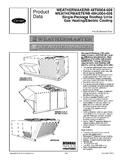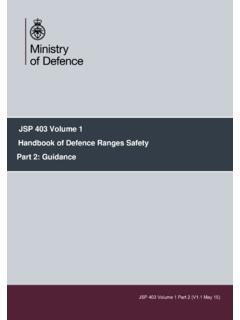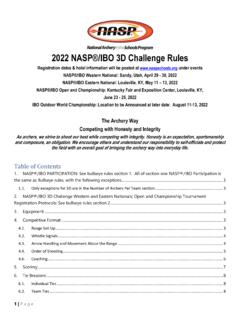Transcription of NFAA Archery and Bowhunter Range Guidelines
1 NFAA Archery and Bowhunter Range Guidelines by Paul H. Davison Consultant, Archery Range Development i SPECIAL NOTICES There are no restrictions on the reproduction and distribution of this material; however, it will be appreciated if acknowledgment is made of its source, its author, and its sponsors. It is suggested that all questions regarding document maintenance and change control be directed to the author at These Guidelines are the abridged and updated Range Guidelines originally documented in Archery and Bowhunter Range Guidelines , published by the author during the period 1992-1995.
2 These Guidelines are presented for information only, and are not to be treated as officially certified design or safety specifications. Neither the author nor the NFAA assume any liability for the use or misuse of these Guidelines . ii CONTENTS I Summary of outdoor Archery Field Target outdoor Target Bowhunter II outdoor Range Layout and Size Field Archery Target Archery Bowhunter III outdoor Target Butt and Backstop Field Target 2-D Animal 3-D Animal IV.
3 outdoor Range Facilities and Items Any Archery Range Can Field Archery Range Target Archery Range Bowhunter Range V Designing an outdoor Range for General Range Field Archery Range Bowhunter Range VI Summary of Indoor Archery NFAA/IFAA Indoor Vegas VII Indoor Range Layout and Size Shooting Lane Width and Side Height Overall Range VIII Indoor Target Butt and Backstop Target Butt Target Butt and Backstop IX Indoor Range Lighting, Accessories, Special Equipment and Routine Indoor Range Specific Items Needed for Indoor Leagues and Some Special Safety Precautions for Indoor X Designing a Range for Wheelchair Types of Physically Disabled Indoor outdoor Target Field Archery and Bowhunter iii INTRODUCTION In 1991, as part of a nationwide program to develop new and more places for bowhunters and recreational archers to learn.
4 Practice and demonstrate their skills, the American Archery Council (AAC), under principal sponsorship of the Archery Manufacturers and Merchants Organization (AMO), began providing some basic Guidelines for the acquisition and development of Archery and Bowhunter ranges . The fourth and most popular booklet in the series was Archery and Bowhunter ranges Guidelines , revised most recently in 1995, and now out of print. The fifth booklet, Cost Sharing the Development of Archery ranges , revised most recently in 1994, was published by the AMO as a comprehensive guide to sources of financial and advisory assistance.
5 Although still somewhat useful, the Guidelines listed in both booklets are out of date. The original Archery and Bowhunter ranges Guidelines defined Range , target butt, and safety design criteria for virtually every indoor and outdoor Archery game offered by the major, competition-oriented, Archery and Bowhunter organizations in the United States. The amount of detail describing the games in this document is substantially reduced, and is limited to summaries of those games sanctioned by the National Field Archery Association (NFAA) in the USA, and to subtle variations of these games sanctioned worldwide by the International Field Archery Association (IFAA).
6 The Range design criteria presented, however, are little different from that published in the original Archery and Bowhunter Range Guidelines . Section I leads off with a cursory description of almost all outdoor Archery games defined by the NFAA and IFAA. These games come in three versions: Field Archery , Target Archery and Bowhunter Rounds. Section II then attempts to define basic lay-out design criteria for each version. Section III follows with outdoor target butt and backstop construction, including some do-it-yourself ideas, while Section IV lists several "Don't Forget" items and equipment needed to make a successful field, target and Bowhunter Range .
7 Section V is a comprehensive list of outdoor Range safety issues, which, in the final assessment, determines whether your Range is GO or NO-GO for hosting competitive events. Section VI summarizes the most popular NFAA/IFAA indoor Archery games. Then, based on the fact that nearly all indoor Archery games are shot at 20 yards, minimum dimensions (length, width and height) for an indoor Range are recommended in Section VII. Requirements and suggestions related to indoor target butts, backstops, lighting, peripheral equipment, and safety are outlined in Section VIII and Section IX.
8 Finally, in Section X, and as an addendum to the original Guidelines , a few design Guidelines for making ranges wheelchair accessible are outlined. These Guidelines contain very little original material. All target and round descriptions are merely summaries of official rules and regulations documented in the NFAA Constitution and By-Laws and the IFAA Book of Rules. Specific shooting and scoring rules are not delineated herein. Furthermore, these Guidelines do not address any aspects of commercial Archery Range development; such as, design specifications, drawings, financing, construction, insurance and retail management.
9 To be more emphatic: THE Guidelines HEREIN ARE NOT INTENDED TO BE STAND ALONE. NO ATTEMPT SHOULD BE MADE TO SET UP A Range OR COMPETITIVE Archery PROGRAM WITHOUT CONTACTING AND/OR JOINING THE NFAA NATIONAL ORGANIZATION 1 SECTION I SUMMARY OF outdoor Archery GAMES Field Archery Field Archery is a roving Archery game in which successive targets are shot at varying distances. The game was created as a practice round for bowhunters, but was soon standardized as a competitive round for any archer to enjoy.
10 In a way, field Archery is analogous to golf, as is sporting clays analogous to field Archery ; that is, each "target" is different, and you move from "hole-to-hole." NFAA/IFAA Field Round Standard Unit. A standard unit consists of four shots each at 14 different targets. The 14 targets are (not in any order): 15, 20, 25 and 30 yards at a 35-cm face (4 total). 40, 45 and 50 yards at a 50-cm face (3 total). 55, 60 and 65 yards at a 65-cm face (3 total). 35-yd, 4-position "fan" at a 50-cm face (1 total).









